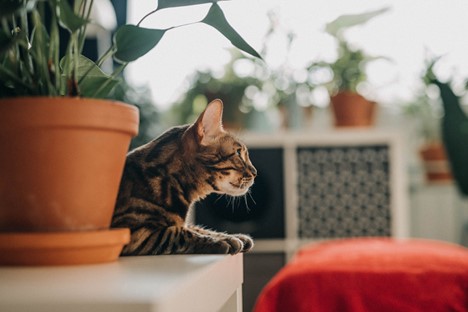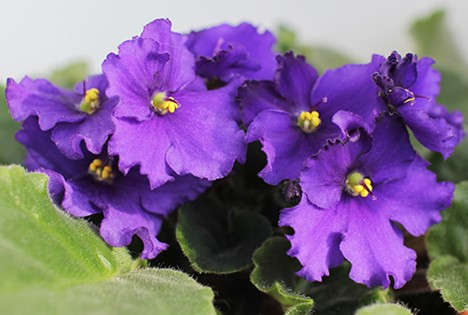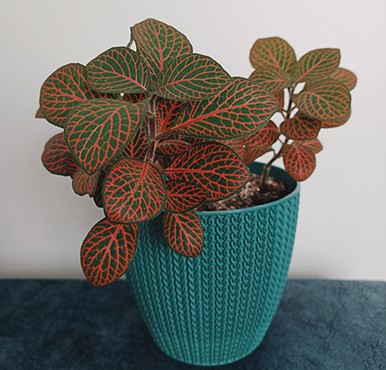
The unfortunate truth is that a lot of common plants are toxic to both cats and dogs. Pets that consume some plants may experience convulsions, tremors, or even worse effects that are toxic, including death.
We asked Judy Morgan, a veterinarian in New Jersey, for her recommendations on how to choose houseplants that won’t hurt the canine companions in our lives because even the best-behaved canines are inevitably going to eat one at some point.
Check out the list of our favorite nontoxic plants that are safe for cats and dogs since we highly recommend adding greenery to your home to enhance the air quality and your mood while also ensuring the safety of your four-legged companion.
1. Ponytail Palm
This is an attractive and pet-friendly houseplant, but you might not recognize it right away. This water-saving plant is perfect for people who are disorganized about their watering schedule or who spend a lot of time away from home. Its bulbous trunk retains water.
Care Guidelines
Ponytail palms are great for people who are notoriously afraid of plants because they only require fertilization two to three times a year. Make sure not to overwater them because they need dry soil.
2. Spider Plant
This plant is popular among veterinarians and is easy to cultivate indoors. It is also remarkably tough (yes, even to your black thumb!). Spider plants can help remove toxins from your home because they are excellent air purifiers.
Care Guidelines

Direct sunlight doesn’t agree with spider plants (it scorches their leaves). They can tolerate lower light levels, but indirect, intense light at temperatures from 60 to 80 degrees Fahrenheit is where they thrive.
The calathea, commonly referred to as a zebra plant, has unusually big, striped leaves. Calathea prefers less direct sunlight, so it is best to place it in a shadier area of the house.
3. Calathea
Care Guidelines
If nurtured in a humid, shaded area, calapheas can flourish in almost any house. Place your plant in a humid setting, such as a bathroom, and keep the temperature above 70 degrees. As an alternative, have a humidifier close by. Calatheas also need a lot of water, so give the plant a weekly watering while making sure the soil doesn’t dry out.

4. African Violet
These blooms would make a lovely, vibrant complement to any open shelving you may have in your kitchen. (Just make sure the plant isn’t next to a draughty floor vent or window.) They will blossom beautifully in shady sunshine.
Care Guidelines
When these blooms are young, they like temperatures between 73- and 77-degrees Fahrenheit, but you can lower the temperature for mature plants to as low as 68 degrees. They’ll require only light water (try to put water under the leaves). Regular fertilization will help them bloom all year. If your plant is struggling, read this article for two ways to revive an African violet.
5. Gloxinia
These native Brazilian flowers will bloom in vivid hues of purple, pink, red, or blue if you can find a window that receives plenty of sunlight. To ensure the healthiest blooms, water the soil often and feed the plants liquid plant food every two weeks.
Care Guidelines
These blossoms should be kept at 71 to 75 degrees Fahrenheit. The seeds should begin to sprout in about three weeks if you allow them to sit in warm, indirect sunshine.

6. Boston Fern
The lovely Boston fern, which only needs nourishment every two months, is on the low-maintenance end of the maintenance scale. Both cats and dogs may safely consume this plant, so feel free to let your pet bat at the fronds or even take a piece.
Care Guidelines
The gorgeous Boston fern is another example of a low-maintenance plant that only requires feeding every two months. You can let your pet bat at the fronds or even take a piece of this plant because it is safe for both cats and dogs to eat.
7. Cast Iron Plant
The cast iron plant is a beautiful sight, growing up to a height of two to three feet and covered in rich green foliage. Since it grows slowly and can endure harsh conditions, it is a favorite indoor plant for individuals who lead busy lives.
8. Staghorn Fern
This fern has two different types of fronds and is native to Australia. The pet-friendly plant can be hung in a basket, mounted on a wall, or potted. The staghorn fern will thrive in any environment with direct or bright light, but not in one that is completely dark. You can water it every one to three weeks, depending on the temperature and humidity (the more humidity, the less you need to water it). You only need to water and mist it once every three weeks if you put it in a bathroom.
Care Guidelines
Keep your staghorn ferns between 60- and 80-degrees Fahrenheit in loose, quick-draining soil.
9. Moth Orchid
Few plants have a more refined air than an orchid. Thankfully, you can incorporate one into your house without endangering your dog.
Care Guidelines

This Asian native orchid breed thrives naturally in locations that are partially sunny, warm, and humid. It usually blooms once a year for up to three months; after that, the plants wither and go dormant, but the blooms will come again the next season. If the leaves start to turn yellow, you may be overwatering them or they are getting too much direct sunlight. If you are new to orchids, read this article that gives you seven ways to guarantee healthy orchids.
10. Fittonia
Fittonia is a creeper that grows slowly and has red veins on its leaves. It features silvery linings all over its bright green foliage, including the leaves. It is a low-maintenance indoor plant that can grow to be 10 to 12 inches tall.
Related Articles & Free Email Newsletter Sign Up
3 Indoor Plants That are Low Maintenance and Dog Friendly




Comment here